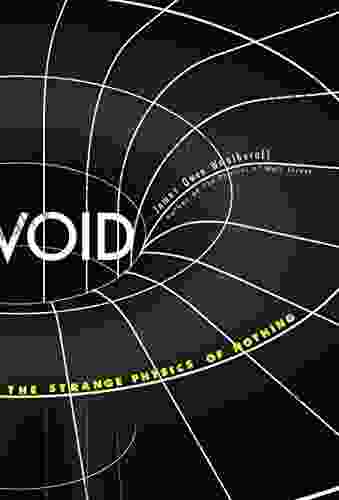The Strange Physics Of Nothing: Foundational Questions In Science


The concept of "nothing" has always been a source of fascination and debate in the realm of science. It is a paradoxical concept that challenges our understanding of the universe and forces us to confront the very nature of reality. In recent years, the study of "nothing" has emerged as a cutting-edge field of research, known as "nothingness physics." This field explores the strange and mind-boggling properties of the vacuum, which is often thought of as empty space.
4.1 out of 5
| Language | : | English |
| File size | : | 773 KB |
| Text-to-Speech | : | Enabled |
| Screen Reader | : | Supported |
| Enhanced typesetting | : | Enabled |
| Word Wise | : | Enabled |
| Print length | : | 205 pages |
| Lending | : | Enabled |
Contrary to our everyday experience, the vacuum is far from being truly empty. It is actually a seething cauldron of activity, filled with virtual particles that constantly pop into and out of existence. These particles emerge from the void, only to annihilate each other and disappear back into nothingness. This constant dance of creation and annihilation gives rise to a variety of strange and counterintuitive phenomena.
The Vacuum Energy Conundrum
One of the most perplexing aspects of nothingness is the existence of vacuum energy. According to the laws of quantum mechanics, even in the absence of any matter or radiation, space contains a non-zero amount of energy. This energy is known as vacuum energy, or dark energy, and it is thought to be responsible for the observed acceleration of the universe's expansion.
The magnitude of vacuum energy is extremely small, but it is nonetheless significant. It has been calculated that the vacuum energy density is roughly 10^-9 joules per cubic meter. This may seem like a tiny amount, but it is enough to have a profound impact on the universe's fate. Vacuum energy acts as a repulsive force, driving the expansion of the universe at an ever-increasing rate.
The existence of vacuum energy raises fundamental questions about the nature of space and time. It suggests that space is not merely a passive backdrop for matter and energy but rather an active participant in the evolution of the universe.
The Casimir Effect
One of the most striking manifestations of vacuum energy is the Casimir effect. This effect was predicted by the Dutch physicist Hendrik Casimir in 1948 and experimentally verified decades later. The Casimir effect describes the attractive force between two uncharged conducting plates placed in close proximity.
The Casimir effect arises from the interaction of virtual particles with the conducting plates. The plates act as a boundary condition for the virtual particles, causing them to be confined to a smaller space. This reduces the number of virtual particles between the plates, resulting in a net attractive force.
The Casimir effect has important implications for nanotechnology and other fields where precise control over the interactions between objects is essential. It also provides experimental evidence for the existence of vacuum energy.
The Hawking Radiation
Another mind-boggling consequence of nothingness is the Hawking radiation. This radiation is emitted by black holes, which are regions of spacetime where gravity is so strong that nothing, not even light, can escape.
According to Stephen Hawking, black holes are not completely black but emit a faint glow of radiation. This radiation arises from the interaction of virtual particles near the event horizon, the boundary of a black hole. One particle falls into the black hole, while the other escapes as Hawking radiation.
The Hawking radiation has important implications for our understanding of black holes. It suggests that black holes are not eternal but will eventually evaporate over time. The Hawking radiation also provides a potential way to probe the nature of spacetime and gravity near the black hole singularity.
The Arrow of Time
The study of nothingness has also shed light on the fundamental question of the arrow of time. Why does time flow in one direction, from past to future?
Some physicists believe that the answer to this question lies in the vacuum. The vacuum is not time-symmetric, meaning that its properties change as time flows. This asymmetry may be responsible for the emergence of the arrow of time.
One possible mechanism for the generation of the arrow of time is the Hawking radiation. As black holes evaporate, they emit Hawking radiation that is not time-symmetric. This asymmetry may be transferred to the surrounding spacetime, giving rise to the arrow of time.
The study of nothingness is a frontier of modern physics that is challenging our understanding of the universe and the nature of reality. From the vacuum energy conundrum to the Hawking radiation, the strange physics of nothing is forcing us to confront fundamental questions about space, time, and the arrow of time.
As we continue to probe the depths of nothingness, we may uncover even more mind-boggling phenomena that will further revolutionize our understanding of the cosmos. The study of nothing is a journey into the unknown, a quest for knowledge that may ultimately lead us to the very essence of reality.
4.1 out of 5
| Language | : | English |
| File size | : | 773 KB |
| Text-to-Speech | : | Enabled |
| Screen Reader | : | Supported |
| Enhanced typesetting | : | Enabled |
| Word Wise | : | Enabled |
| Print length | : | 205 pages |
| Lending | : | Enabled |
Do you want to contribute by writing guest posts on this blog?
Please contact us and send us a resume of previous articles that you have written.
 Top Book
Top Book Novel
Novel Fiction
Fiction Nonfiction
Nonfiction Literature
Literature Paperback
Paperback Hardcover
Hardcover E-book
E-book Audiobook
Audiobook Bestseller
Bestseller Classic
Classic Mystery
Mystery Thriller
Thriller Romance
Romance Fantasy
Fantasy Science Fiction
Science Fiction Biography
Biography Memoir
Memoir Autobiography
Autobiography Poetry
Poetry Drama
Drama Historical Fiction
Historical Fiction Self-help
Self-help Young Adult
Young Adult Childrens Books
Childrens Books Graphic Novel
Graphic Novel Anthology
Anthology Series
Series Encyclopedia
Encyclopedia Reference
Reference Guidebook
Guidebook Textbook
Textbook Workbook
Workbook Journal
Journal Diary
Diary Manuscript
Manuscript Folio
Folio Pulp Fiction
Pulp Fiction Short Stories
Short Stories Fairy Tales
Fairy Tales Fables
Fables Mythology
Mythology Philosophy
Philosophy Religion
Religion Spirituality
Spirituality Essays
Essays Critique
Critique Commentary
Commentary Glossary
Glossary Bibliography
Bibliography Index
Index Table of Contents
Table of Contents Preface
Preface Introduction
Introduction Foreword
Foreword Afterword
Afterword Appendices
Appendices Annotations
Annotations Footnotes
Footnotes Epilogue
Epilogue Prologue
Prologue Dee Brown
Dee Brown Thomas Bulfinch
Thomas Bulfinch Logan C Kane
Logan C Kane Honey Jaks
Honey Jaks James Owen Weatherall
James Owen Weatherall David M Killoran
David M Killoran Emily Meggett
Emily Meggett Derrick Austin
Derrick Austin Salam Khan
Salam Khan Creative Child
Creative Child Cindy Goldrich
Cindy Goldrich Lawrence C Ross
Lawrence C Ross Rachael Ray
Rachael Ray Robert Gardner
Robert Gardner Jorie Graham
Jorie Graham Eric Schlosser
Eric Schlosser Tj Waters
Tj Waters Litmux Books
Litmux Books Mike Evans
Mike Evans Thomas Henry Huxley
Thomas Henry Huxley
Light bulbAdvertise smarter! Our strategic ad space ensures maximum exposure. Reserve your spot today!
 Isaac MitchellFollow ·7k
Isaac MitchellFollow ·7k Fletcher MitchellFollow ·11.2k
Fletcher MitchellFollow ·11.2k Braeden HayesFollow ·12k
Braeden HayesFollow ·12k Dave SimmonsFollow ·17.2k
Dave SimmonsFollow ·17.2k Rick NelsonFollow ·3.1k
Rick NelsonFollow ·3.1k Mark MitchellFollow ·7.7k
Mark MitchellFollow ·7.7k Earl WilliamsFollow ·8.8k
Earl WilliamsFollow ·8.8k Owen SimmonsFollow ·13.4k
Owen SimmonsFollow ·13.4k

 Edwin Cox
Edwin CoxThe Great Deliverance Inspector Lynley: A Literary...
: In the realm of detective fiction,...

 Christian Carter
Christian CarterMetal Gear Solid Ground Zeroes Guide, Walkthrough, Tips,...
Metal Gear Solid...

 Branden Simmons
Branden SimmonsYellow Green: Not an Autobiography of Marcy Chen
Yellow Green:...

 Edward Reed
Edward ReedPurple Orchids: An Artistic Tale of Two Sisters in the...
Prologue: A Legacy Unveiled In the...

 Earl Williams
Earl WilliamsThe Evolving Housing Market Dynamics in Africa:...
The African housing market is a...

 William Faulkner
William FaulknerVoices In My Head: A Cerebral Symphony of Terror
In the labyrinthine...
4.1 out of 5
| Language | : | English |
| File size | : | 773 KB |
| Text-to-Speech | : | Enabled |
| Screen Reader | : | Supported |
| Enhanced typesetting | : | Enabled |
| Word Wise | : | Enabled |
| Print length | : | 205 pages |
| Lending | : | Enabled |












